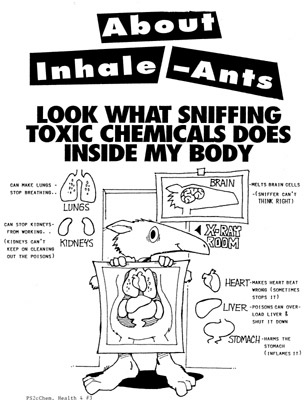| Introduction
| Principles | Innovation
| History | What
is Inhalant Abuse?
Background:
Diffusion of Innovation
Diffusion
of innovation is “the process by which an innovation is communicated
through certain channels over time among members of a social system.”
– Rogers, 1995
|

|
Graphic by Mark Groves, Eden Family Project, Minneapolis, MN
Click on graphic to enlarge
|
The
Diffusion of Innovation model was developed by Everett M. Rogers
(Diffusion Of Innovations 1993, fifth edition) to describe how new
ideas and technologies are spread through society. Examples include
cell phones, the internet, and DVD players, but can also include
new ideas, like “germs cause disease” or best practices
in substance abuse prevention.
The
research on Diffusion of Innovation describes how innovations diffuse
through society over time.
-
Innovators are risk-takers who see the benefit of an innovation
and launch it
-
Early adopters are often opinion leaders in their local social
systems - who people go to before adopting a new
idea. They are role models and are respected by their peers.
-
Early Majority folks are deliberate and careful in adopting innovation.
-
Late Majority folks are skeptical of change and wait until an
innovation is thoroughly tested before slowly adopting it, sometimes
only as a result of peer pressure.
-
Laggards are the last to adopt an innovation and may be somewhat
isolated and traditional.
Often
a lot of work must be done in the early stages of diffusion but at
some point enough people have adopted the innovation that it starts
to have a life of its own and we say that the innovation seems to
just ‘take off.’ This is called the “critical
mass” or “tipping point.” At this point, the process
of innovation becomes self-sustaining.
The
model also suggests characteristics of an innovation that make it
more or less likely to be adopted:
- How
compatible is it with how people or organizations already operate?
With their values?
- What
will it cost to adopt the innovation?
- How
complex is the innovation?
-
What are the benefits of adopting this innovation relative to
the current practice? To what extent is the benefit obvious and
observable?
-
Can the innovation be adopted a bit at a time so it can be tested?
|
How We Applied Diffusion of Innovation Model
We started by applying diffusion of innovation concepts to our approach. We encouraged states to find their inhalant champions and opinion leaders. We sought to make our new messages memorable and sticky. We designed tools that show how to tweak existing prevention efforts. We provided trainings where people could observe and practice how to use the new messages effectively. Each state's Task Force was built upon a structure uniquely compatible to their state. We mentored early adopters and provided a forum for support across states (The Coalition Workgroup). We provided access to national experts to support the states as they diffused innovation, translated it into practice, and adapted materials and strategies to suit their needs. We kept the psychological and actual costs of implementation low. We encouraged broad-based participation from non-traditional partners to expand the network. Helped by the cogency of the message, we found it was easy to find early adopters. And most important, our goal is to reach the 'tipping point" so that the process of diffusing inhalant prevention best practices becomes self sustaining.
|
|


